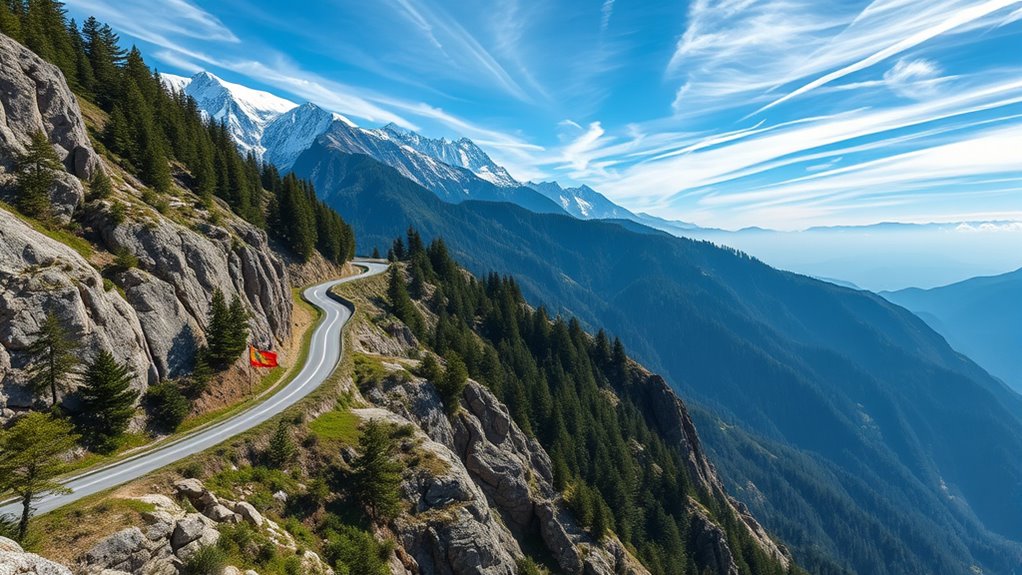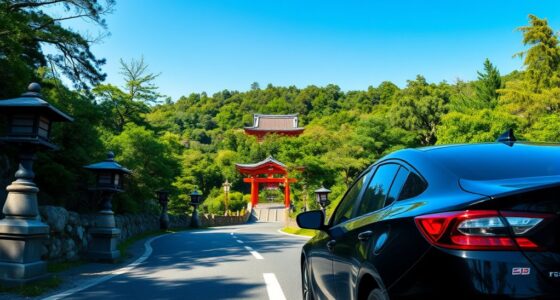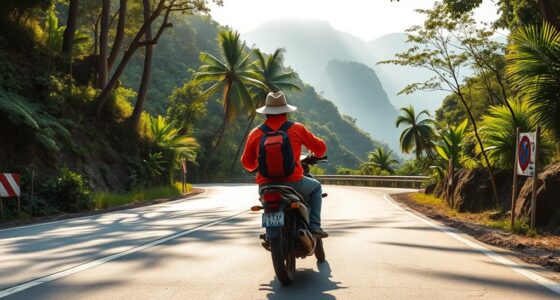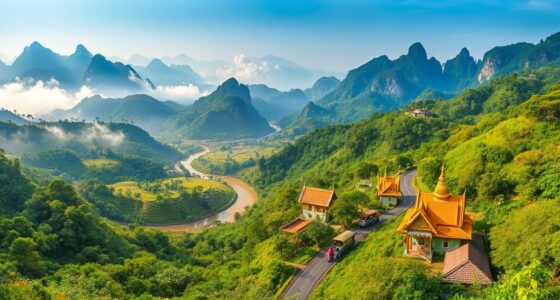Bhutan’s Trans-Himalayan East-West Highway is a crucial route that connects remote communities, cultural landmarks, and natural wonders across rugged mountain terrain. You’ll encounter breathtaking landscapes, historic monasteries, and sacred sites along the way. The highway faces engineering challenges like landslides, steep slopes, and high-altitude conditions, but ongoing upgrades aim to improve safety and access. If you continue exploring, you’ll discover how this route shapes Bhutan’s culture, environment, and future connectivity.
Key Takeaways
- The Trans-Himalayan East-West Highway connects Bhutan’s remote eastern and western regions, facilitating national connectivity and regional trade.
- It has historical roots as an ancient trade route, passing through sacred sites and culturally significant landmarks.
- The highway faces engineering challenges due to rugged terrain, requiring advanced construction methods and infrastructure upgrades.
- Key destinations along the route include Paro Valley, Thimphu, and Bumthang, known for their natural beauty and cultural heritage.
- The route supports spiritual pilgrimages, traditional festivals, and promotes local tourism, cultural preservation, and community development.
The History Behind Bhutan’s Trans-Himalayan Route
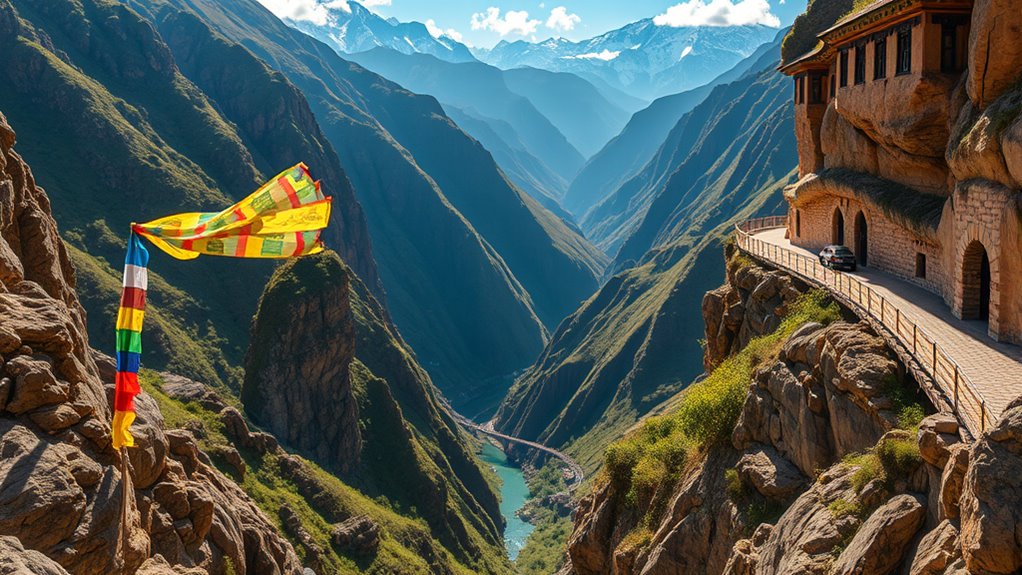
Have you ever wondered how Bhutan’s Trans-Himalayan route came into existence? It’s rooted in ancient trade and traditional pathways that connected Bhutan to neighboring regions. Traders used these routes for centuries, charting rugged mountain passes and narrow trails, forming the backbone of early commerce and cultural exchange. These pathways weren’t designed for modern vehicles but served as crucial links for communities, facilitating the movement of goods like salt, spices, and textiles. Over time, these historic routes laid the groundwork for modern infrastructure, reflecting Bhutan’s rich history of trade and connectivity. The mountain terrain posed significant challenges, yet the importance of these traditional pathways remains evident in how they shaped Bhutan’s development and cultural ties in the Himalayan region. Additionally, the historic trade routes evolved over centuries, influencing the development of regional networks and fostering cross-cultural interactions. The legacy of trade routes continues to influence contemporary transportation planning and regional cooperation efforts. Recognizing the significance of geography helps us understand how these routes adapted to the rugged landscape and remained vital for regional integration.
Engineering Challenges in Mountainous Terrain
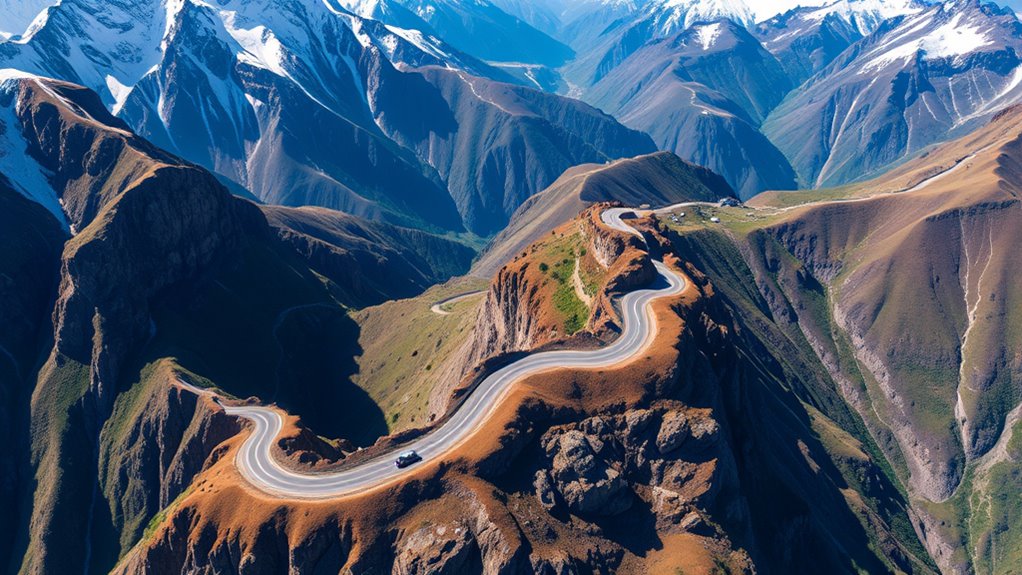
Constructing the Trans-Himalayan Highway presents formidable engineering challenges due to the region’s rugged and unpredictable terrain. You must master mountain engineering to navigate steep slopes, unstable ground, and frequent landslides. Adapting construction techniques is vital; you’ll rely on advanced geotechnical methods to stabilize slopes and prevent erosion. Building in high altitudes means dealing with thin air and extreme weather, which complicates machinery operation and worker safety. You’ll also need innovative solutions for bridging deep gorges and tunneling through solid rock. Precise planning and specialized equipment are essential to guarantee structural stability and longevity. Incorporating specialized spray tips and other advanced construction tools can improve coating applications and weatherproofing efforts in these harsh conditions. Using erosion control measures is critical to prevent landslides and maintain the integrity of the highway during construction. Employing mountain engineering techniques is crucial for overcoming the difficult terrain and ensuring project success. Additionally, understanding the geotechnical properties of the terrain helps optimize foundation design and stability. To effectively manage these complex challenges, integrating innovative construction materials tailored for high-altitude environments is increasingly important. Overcoming these mountain engineering hurdles demands ingenuity, resilience, and a deep understanding of the terrain’s unique challenges.
Key Destinations Along the Highway
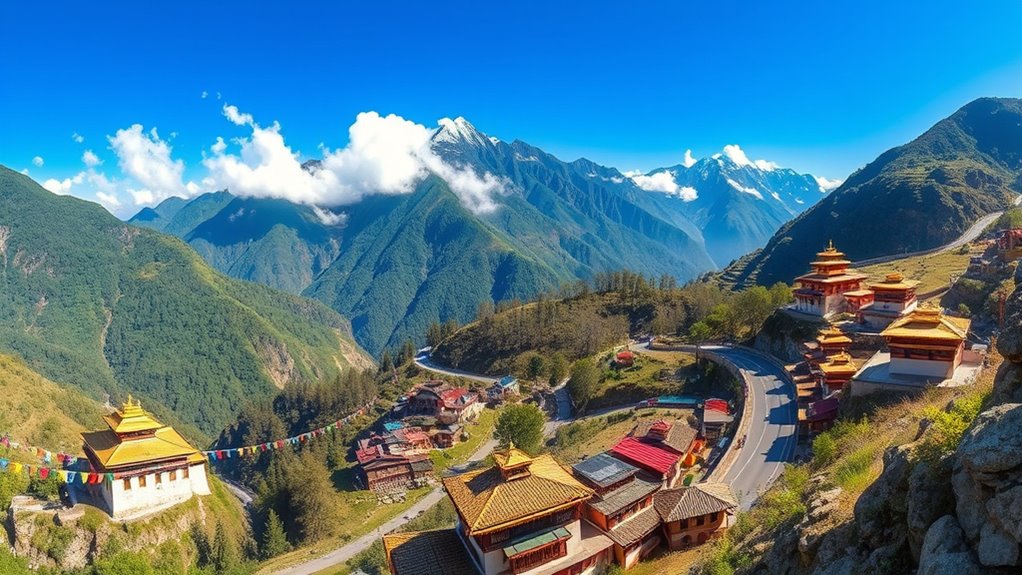
As you travel along the highway, you’ll encounter some of Bhutan’s most mesmerizing destinations. From the lush beauty of Paro Valley to the vibrant culture of Thimphu, each stop offers unique experiences. Don’t miss the ancient temples and traditions in Bumthang, which add even more richness to your journey. Paying attention to visual experience can greatly enhance your appreciation of the scenic landscapes and cultural sites along the route. Exploring the scenic landscapes and their diverse features can deepen your understanding of Bhutan’s natural beauty and cultural heritage, which is integral to the region’s identity. Incorporating traditional architecture such as Bhutanese dzongs and monasteries in your observations can further enrich your cultural appreciation.
Paro Valley Highlights
Did you know that Paro Valley is one of the most enchanting destinations along Bhutan’s Trans-Himalayan East-West Highway? As you explore, you’ll discover stunning landscapes, ancient monasteries, and vibrant culture. Don’t miss trying the local cuisine, which features hearty dishes like ema datshi and momos that give you a true taste of Bhutanese flavor. If you time your visit right, you might experience one of the valley’s traditional festivals, where colorful masks, dance, and music bring the community together. Paro’s blend of natural beauty and cultural richness makes it a highlight along the highway. Additionally, exploring the heartfelt expressions of cultural pride can deepen your appreciation for Bhutan’s unique identity. Recognizing the importance of sustainable tourism practices can help preserve the valley’s pristine environment for future generations. Embracing mindful decluttering strategies can also enhance your experience by allowing you to focus more on meaningful connections during your visit. Incorporating energy-efficient heat pump technology into local infrastructure can support Bhutan’s commitment to environmental sustainability.
Thimphu City Attractions
Thimphu, Bhutan’s vibrant capital, stands out as a key destination along the Trans-Himalayan East-West Highway with its blend of tradition and modernity. As you explore the city, you’ll discover lively markets and charming cafes serving local cuisine like ema datshi and momos, giving you a taste of Bhutanese flavors. Don’t miss visiting iconic sites like Tashichho Dzong, which showcases impressive architecture and spiritual history. If you time your visit right, you can experience traditional festivals such as Tsechu, where colorful masked dances and cultural performances fill the streets with energy. Thimphu offers a perfect mix of cultural immersion and contemporary life, making it a must-see stop along your journey.
Bumthang Cultural Sites
Nestled along the Trans-Himalayan East-West Highway, Bumthang is a cultural treasure trove filled with historic sites and spiritual landmarks. As you explore, you’ll encounter vibrant Bumthang festivals that showcase traditional dances and rituals, offering deep insights into local customs. Don’t miss visiting ancient monasteries like Jambay Lhakhang and Kurjey Lhakhang, where centuries-old spiritual practices continue. You can also immerse yourself in traditional crafts, watching artisans create intricate textiles and woodwork that reflect Bhutanese heritage. These sites and activities give you a genuine sense of Bumthang’s rich history and spiritual life. By experiencing the festivals and crafts firsthand, you gain a deeper appreciation for the enduring cultural traditions along this scenic highway. Additionally, understanding ethical hacking concepts can help protect digital cultural assets and sensitive information associated with these heritage sites. Moreover, ensuring proper financial documentation can facilitate preservation efforts and secure funding for maintaining these important landmarks. Exploring the local community can also provide valuable insights into the ongoing cultural preservation practices in Bumthang. To truly appreciate the significance of these sites, engaging with cultural preservation initiatives can help sustain the region’s unique identity for future generations. Recognizing the role of Glycolic Acid in skin health can serve as a metaphor for maintaining the vitality of cultural heritage through preservation and care.
Scenic Highlights and Natural Wonders
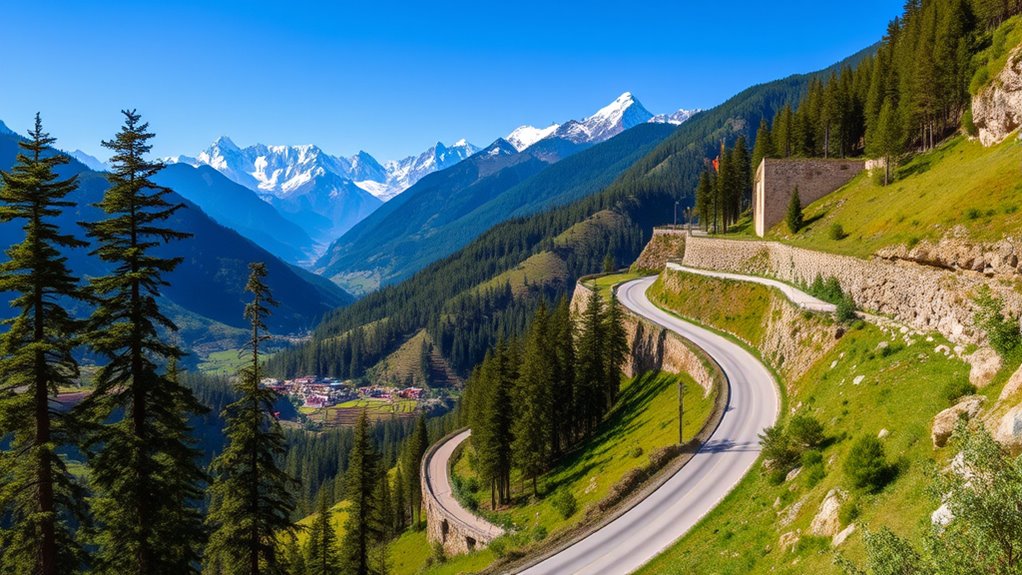
Have you ever wondered what makes Bhutan’s Trans-Himalayan East-West Highway a visual feast? As you travel along, vibrant mountain vistas unfold before your eyes—snow-capped peaks, lush valleys, and dense forests teeming with wildlife encounters. The landscape shifts beautifully, revealing hidden waterfalls, meandering rivers, and expansive meadows bursting with wildflowers. Along the way, you can savor local cuisine that highlights fresh, seasonal ingredients, enhancing your connection to the region’s natural bounty. Wildlife sightings are a highlight, with chances to spot Himalayan blue sheep, red pandas, and colorful bird species in their natural habitats. This route offers a stunning showcase of Bhutan’s natural wonders, blending breathtaking scenery with moments of peaceful serenity and exciting wildlife encounters.
Cultural Significance of the Road
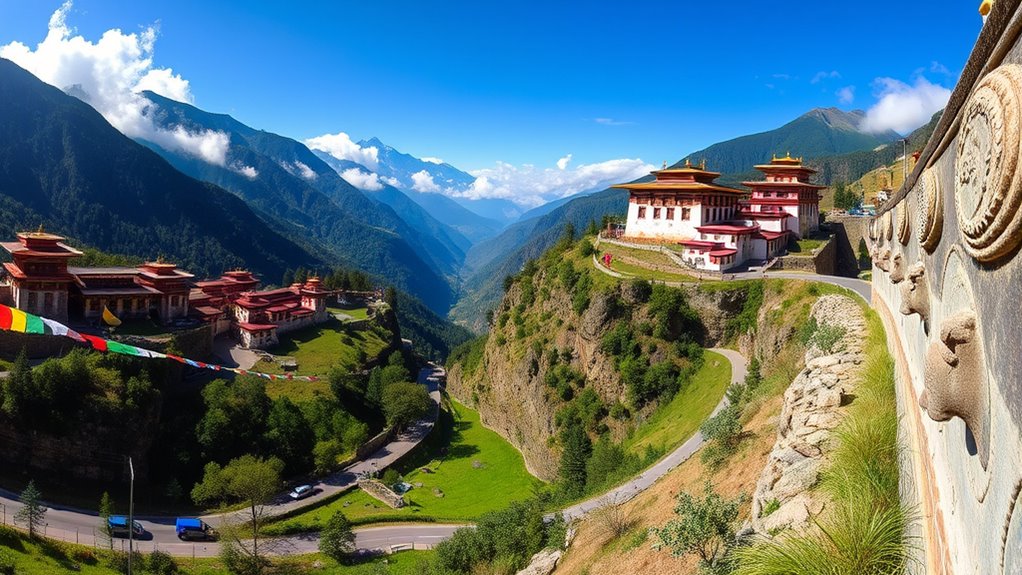
As you travel along the highway, you’ll notice sacred sites that hold deep spiritual meaning for locals. This route has historically served as a crucial trade path and a route for spiritual pilgrimages. Exploring these connections reveals how the road weaves together Bhutan’s cultural and religious heritage.
Sacred Sites Along Route
What makes the Trans-Himalayan East-West Highway particularly significant are the sacred sites scattered along its route, which deepen its cultural importance. These sites include ancient monasteries, prayer flags, and holy caves that draw pilgrims and locals alike. Visiting these places offers a chance to experience Bhutan’s spiritual heritage firsthand. Along the way, you can also explore local cuisine at small eateries near sacred sites, enriching your cultural understanding. Traditional festivals held at these sites showcase vibrant rituals, dance, and music, connecting you directly to Bhutan’s spiritual traditions. As you travel, you’ll witness the harmony between sacred sites and daily life, emphasizing the road’s role in preserving Bhutan’s unique cultural landscape. The route truly embodies spiritual reverence and cultural depth.
Traditional Trade Routes
The sacred sites along the route highlight Bhutan’s rich spiritual heritage, but the Trans-Himalayan East-West Highway also has a deep history as an essential corridor for traditional trade. This road facilitated the exchange of traditional craftsmanship, allowing artisans to share their skills and unique products across regions. You can still find markets where local artisans display handcrafted textiles, woodwork, and jewelry, reflecting centuries-old traditions. Indigenous cuisine also traveled along these routes, with ingredients and recipes passed from one community to another, enriching Bhutan’s culinary diversity. The highway helped preserve cultural practices by connecting remote villages and fostering local economies. As you explore, you’ll witness how these trade routes played a vital role in maintaining Bhutan’s cultural identity through craftsmanship and cuisine that continue to thrive today.
Spiritual Pilgrimages Connection
Many spiritual sites along Bhutan’s Trans-Himalayan East-West Highway serve as pilgrimage destinations, drawing worshippers from across the country and beyond. You’ll find that local legends and spiritual rituals deepen the road’s cultural significance. These sites are often linked to stories of sacred figures or divine events, inspiring reverence among visitors. As you travel, you’ll encounter:
- Sacred monasteries where monks perform ancient spiritual rituals
- Shrines rooted in local legends that attract pilgrims seeking blessings
- Hidden caves believed to be spiritual power spots, connected to myth and tradition
These sites transform the highway into more than just a route; it becomes a journey through Bhutan’s spiritual heart. Your pilgrimage experience is enriched by centuries of faith and cultural heritage woven into the landscape.
Impact on Local Communities and Economy

How has the Trans-Himalayan East-West Highway transformed local communities and their economies? The highway has markedly boosted local livelihoods by improving access to markets, healthcare, and education. With better connectivity, villagers can now sell their goods more easily, leading to increased income and economic growth. Small businesses have flourished along the route, creating jobs and encouraging entrepreneurship. Communities that once relied solely on subsistence farming now benefit from new opportunities in trade and tourism. The highway also reduces travel time, lowering transportation costs and expanding regional integration. Overall, it fosters a sense of progress and stability, empowering local populations to improve their quality of life while fueling economic development throughout Bhutan’s eastern regions.
Environmental Considerations and Preservation Efforts
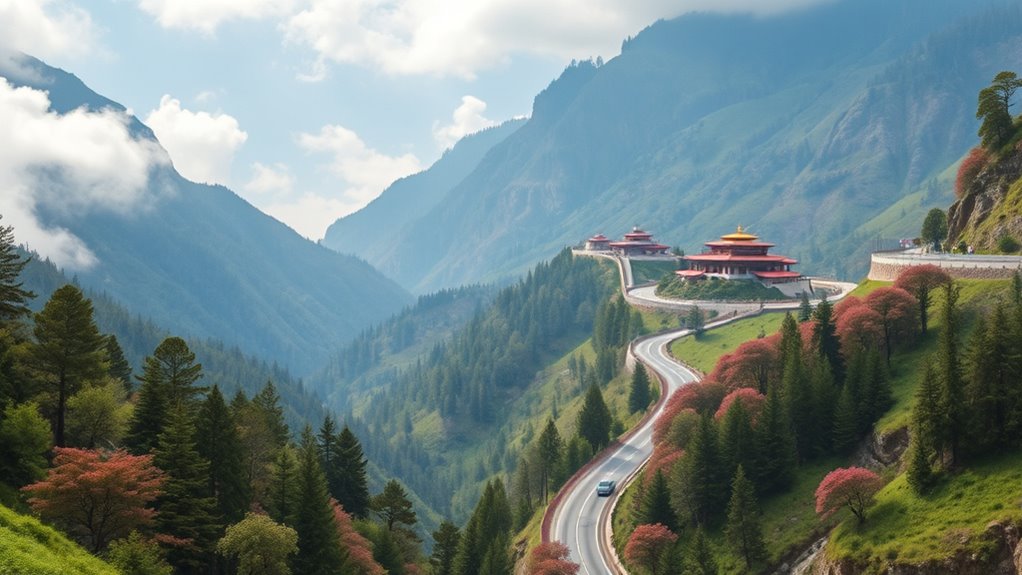
As Bhutan’s eastern regions experience economic growth from the Trans-Himalayan East-West Highway, attention turns to its environmental impact. You need to contemplate the ecological impact this infrastructure has on fragile ecosystems. To protect these areas, conservation initiatives have been implemented, focusing on minimizing habitat disruption. Here are three key efforts:
Bhutan’s infrastructure growth emphasizes conservation to protect fragile ecosystems and promote sustainable development.
- Establishing protected zones along the highway route.
- Conducting environmental impact assessments before construction.
- Promoting community-led conservation programs.
These actions help balance development with environmental preservation. You play a role in ensuring that infrastructure projects prioritize ecological sustainability. Recognizing the importance of conservation initiatives keeps Bhutan’s unique biodiversity safe while supporting regional growth. By integrating environmental considerations into planning, you help safeguard the landscape for future generations.
Ongoing Development and Infrastructure Improvements
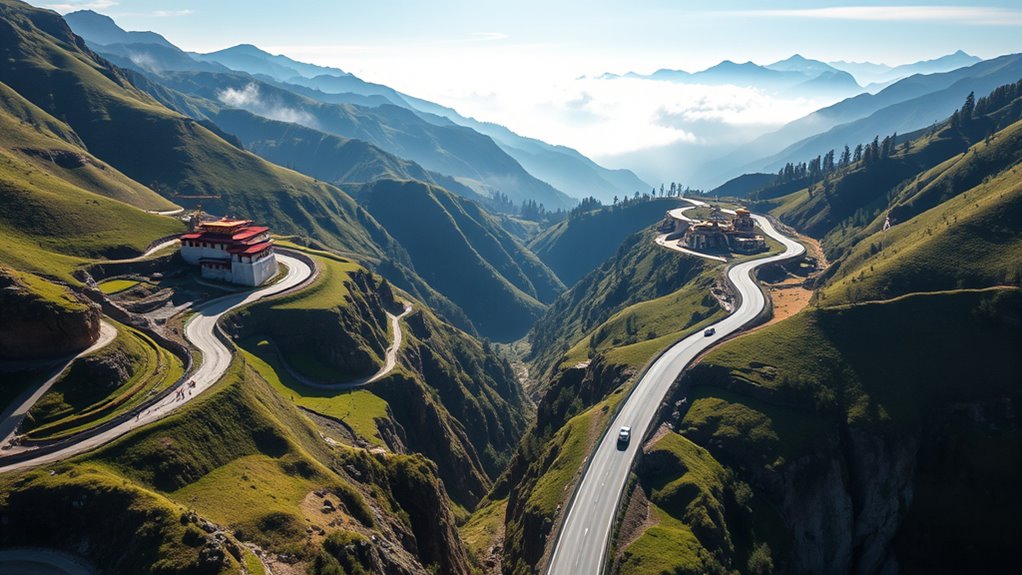
You’ll notice that ongoing development focuses on expanding the road network and upgrading infrastructure to support better travel. Modernization efforts aim to improve safety, efficiency, and resilience along the highway. These connectivity improvements are essential for strengthening regional links and promoting economic growth.
Road Expansion Projects
Bhutan’s ongoing road expansion projects are essential to enhancing connectivity and supporting economic development along the Trans-Himalayan East-West Highway. These improvements will make travel smoother, boost trade, and promote cultural exchange. As roads expand, you’ll find easier access to remote villages where local cuisine and traditional festivals flourish. This development encourages tourism, allowing visitors to experience Bhutan’s vibrant culture firsthand.
Consider these key aspects:
- Upgrading mountain passes for safer, year-round travel.
- Building new bridges to connect isolated communities.
- Improving signage and facilities to support local businesses and cultural sites.
With better roads, you’ll experience Bhutan’s rich traditions more intimately, making every journey along the highway a chance to explore its unique heritage and community life.
Modernization of Infrastructure
Ongoing infrastructure improvements are transforming Bhutan’s transportation landscape by modernizing roads, bridges, and related facilities. These upgrades support local craftsmanship by making it easier to transport traditional handicrafts to markets, preserving cultural heritage. As roads improve, local artisans can showcase their skills more widely, boosting the economy. Additionally, the enhancements benefit culinary traditions by ensuring fresh ingredients reach communities quickly, reducing spoilage. New bridges and well-maintained roads connect remote areas, making travel safer and more efficient. This modernization encourages cultural exchange and preserves Bhutan’s unique identity. It also invites more visitors to experience local craftsmanship and cuisine firsthand, fostering pride and sustainability. Overall, these developments strengthen Bhutan’s cultural fabric while supporting economic growth through improved infrastructure.
Connectivity Enhancements
Connectivity enhancements along Bhutan’s Trans-Himalayan East-West Highway are rapidly transforming how people and goods move across the region. These improvements boost trade, tourism, and cultural exchange. As roads become more reliable, you’ll notice easier access to local cuisine hotspots and opportunities to experience traditional attire firsthand.
Key developments include:
- Upgraded road surfaces and safety features, ensuring smoother journeys.
- New rest stops showcasing local cuisine, giving travelers a taste of Bhutanese flavors.
- Signage and information centers highlighting cultural sites and traditional attire, enriching your travel experience.
These enhancements create a seamless connection between remote communities and urban centers, making it easier for you to explore Bhutan’s rich heritage while supporting local economies.
Traveling the Trans-Himalayan Highway: Tips and Insights
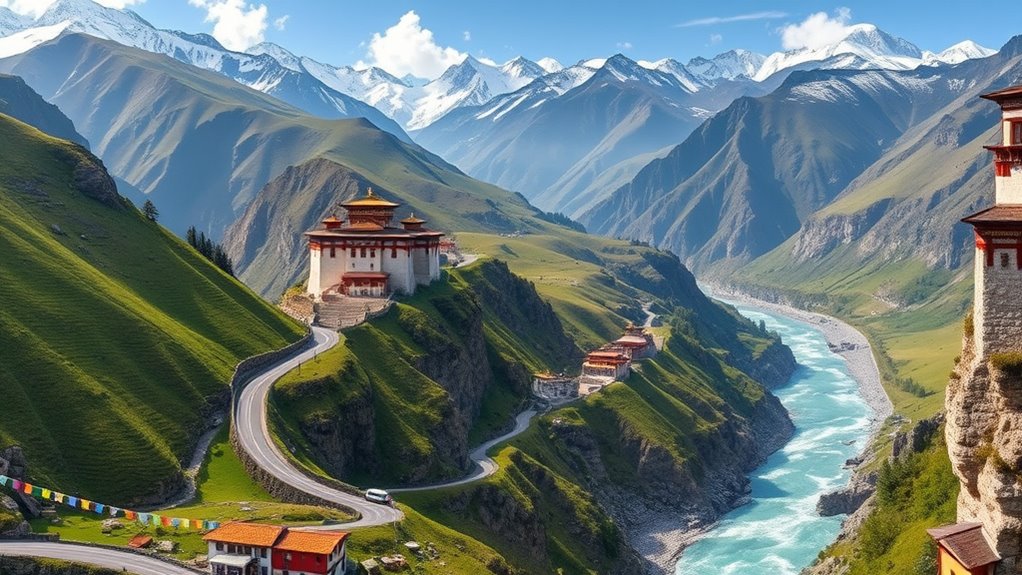
Traveling the Trans-Himalayan Highway offers a breathtaking adventure, but it also requires careful planning to guarantee a smooth journey. Make sure to carry enough supplies, including snacks and water, and dress in layers for changing weather conditions. Take time to enjoy local cuisine at small villages; it’s a great way to experience Bhutan’s culture. Respect wildlife conservation efforts by staying on designated paths and avoiding disturbing animals. Road conditions can vary, so drive cautiously, especially on steep or narrow sections. Keep your camera ready for stunning mountain vistas and unique flora and fauna. Talk to locals when possible— they’re friendly and enthusiastic to share insights about the landscape and traditions. With preparation, your trip becomes an unforgettable exploration of Bhutan’s rugged beauty.
The Future of Connectivity in Bhutan
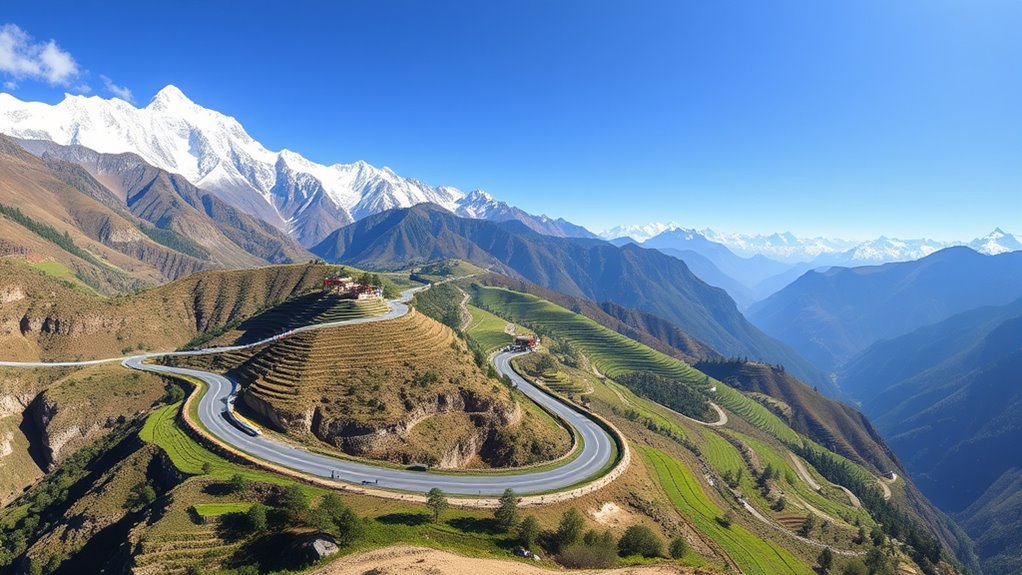
As Bhutan continues to embrace modernization, advancements in communication infrastructure are shaping how people connect across its rugged landscape. The future of connectivity depends on key developments like:
- Aviation development — expanding regional airports to improve domestic and international travel.
- Telecommunications expansion — increasing network coverage and internet speeds to reach remote areas.
- Smart infrastructure — integrating digital systems for transportation, healthcare, and governance.
These efforts will enhance connectivity, boost tourism, and promote economic growth. Improved aviation links will make travel faster and more accessible, while telecommunications expansion will bridge communication gaps. As these sectors evolve, you’ll experience greater access to information, services, and opportunities, transforming how Bhutanese and visitors interact with the country’s landscape and communities.
Frequently Asked Questions
What Is the Current Condition of the Highway During Winter?
During winter, you might find the highway experiencing occasional closures due to heavy snowfall and icy conditions. Snowfall impacts travel profoundly, making certain sections impassable at times. Weather can be unpredictable, so it’s wise to check local updates before your journey. While the highway remains operational most of the time, winter weather can cause delays or closures, so plan accordingly and stay informed about current road conditions.
Are There Any Safety Concerns for Travelers on This Route?
Thinking of hitting the route? Well, safety’s a bit of a wild card—literally. Watch out for wild animal crossings and landslide risks that keep travelers on their toes. Snow and ice can make the journey slippery, so don’t underestimate Mother Nature’s sense of humor. Keep your eyes open, drive carefully, and remember, adventure often comes with a side of caution. Stay safe out there!
How Accessible Is the Highway for International Tourists?
You’ll find the highway quite accessible for international tourists, especially if you’re comfortable with local transportation options. It offers smooth travel through stunning landscapes, making it easy to reach scenic viewpoints along the route. While some drive it independently, guided tours are popular, ensuring you enjoy the breathtaking scenery safely. Overall, the highway’s infrastructure supports travelers, providing a memorable experience as you explore Bhutan’s beautiful east-west corridor.
What Are the Accommodation Options Along the Highway?
Along the highway, you’ll find a range of accommodation options to suit your needs. You can stay in cozy local guesthouses that offer authentic experiences or indulge in luxury resorts for a more lavish stay. Many spots provide stunning views and warm hospitality, making your journey comfortable and memorable. Whether you prefer budget-friendly options or high-end comforts, plenty of choices await you along the route.
Are There Any Restrictions or Permits Required to Travel This Route?
When planning your trip, you should check for travel permits and road restrictions. You’ll likely need special travel permits to access certain areas, especially if you’re crossing borders or visiting protected zones. Road restrictions may vary depending on weather or construction, so stay updated with local authorities or your travel agency. Ensuring you have the correct permits and are aware of restrictions helps you enjoy a smooth, hassle-free journey.
Conclusion
Traveling Bhutan’s Trans-Himalayan Highway offers a breathtaking journey through one of the world’s most rugged terrains. Did you know that over 400 bridges connect remote villages along this route? As you explore, you’ll witness stunning landscapes and rich culture. With ongoing upgrades, this highway promises even better connectivity. Set out on this adventure to experience Bhutan’s natural beauty and resilience firsthand—an unforgettable journey that bridges tradition and progress.
